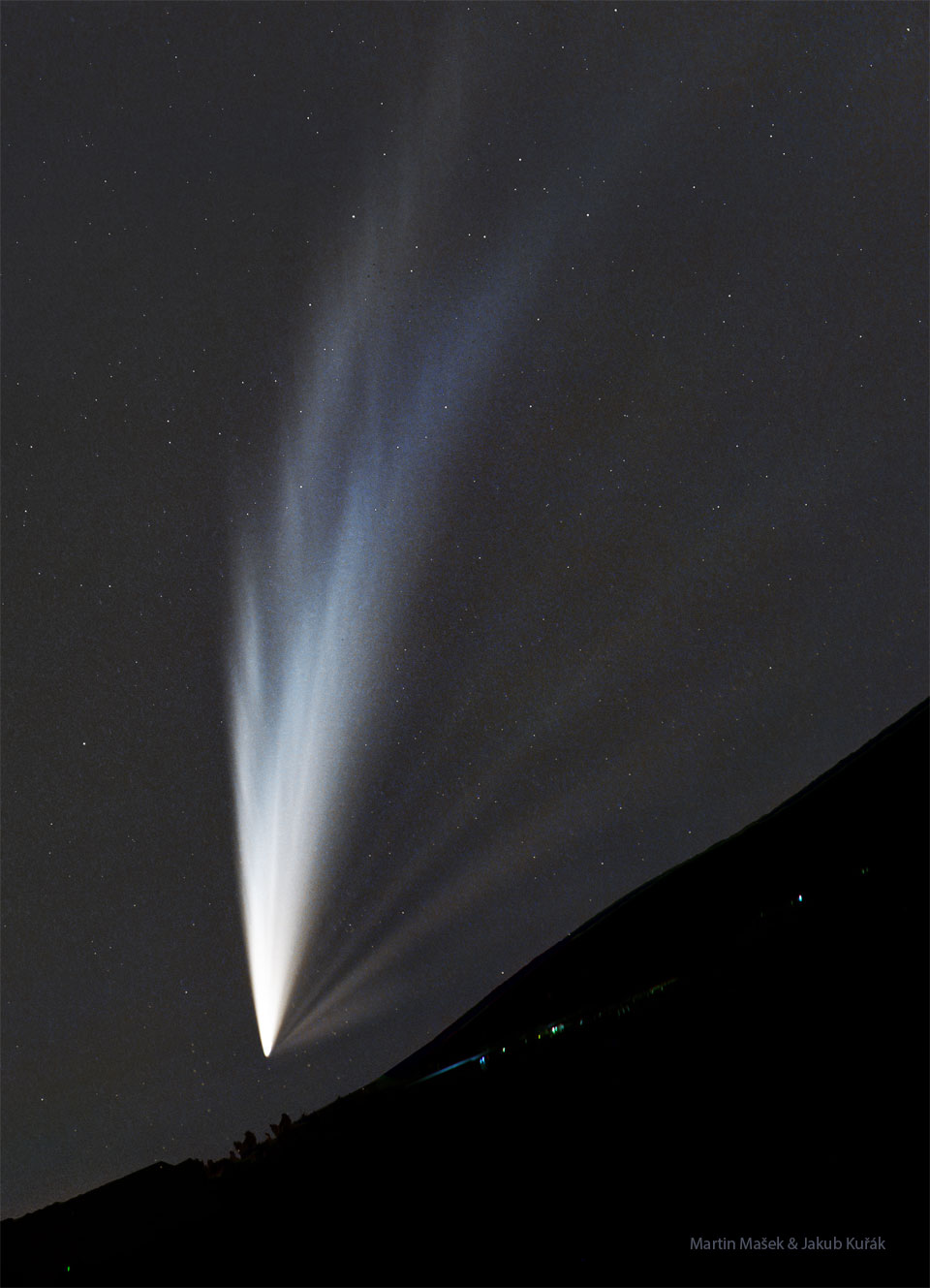Nombre total de pages vues
29/01/2025
ASTRONOMY - Dust Shells around WR 140 from Webb
2025 January 29
Image Credit: NASA, ESA, CSA, STScI, E. Lieb (U. Denver), R. Lau (NSF NOIRLab), J. Hoffman (U. Denver)
Explanation: What are those strange rings? Rich in dust, the rings are likely 3D shells -- but how they were created remains a topic of research. Where they were created is well known: in a binary star system that lies about 6,000 light years away toward the constellation of the Swan (Cygnus) -- a system dominated by the Wolf-Rayet star WR 140. Wolf-Rayet stars are massive, bright, and known for their tumultuous winds. They are also known for creating and dispersing heavy elements such as carbon, which is a building block of interstellar dust. The other star in the binary is also bright and massive -- but not as active. The two great stars joust in an oblong orbit as they approach each other about every eight years. When at closest approach, the X-ray emission from the system increases, as, apparently, does the dust expelled into space -- creating another shell. The featured infrared image by the Webb Space Telescope resolves greater details and more dust shells than ever before. Images taken over consecutive years show the shells moving outward.
28/01/2025
AERONAUTIQUE - La grande épopée des ballons dirigeables - 2012 : Eurêka - le L-ZNT d’Airship Ventures
ASTRONOMY - Comet G3 ATLAS over Uruguay
2025 January 28
Image Credit & Copyright: Mauricio Salazar
Explanation: Comets can be huge. When far from the Sun, a comet's size usually refers to its hard nucleus of ice and rock, which typically spans a few kilometers -- smaller than even a small moon. When nearing the Sun, however, this nucleus can eject dust and gas and leave a thin tail that can spread to an enormous length -- even greater than the distance between the Earth and the Sun. Pictured, C/2024 G3 (ATLAS) sports a tail of sunlight-reflecting dust and glowing gas that spans several times the apparent size of a full moon, appearing even larger on long duration camera images than to the unaided eye. The featured image shows impressive Comet ATLAS over trees and a grass field in Sierras de Mahoma, San Jose, Uruguay about a week ago. After being prominent in the sunset skies of Earth's southern hemisphere, Comet G3 ATLAS is now fading as it moves away from the Sun, making its impressive tails increasingly hard to see.
27/01/2025
SANTé/MEDECINE - A la découverte de l'oreille - Echelle des niveaux sonores
ASTRONOMY - Pleiades over Half Dome
2025 January 27
Image Credit & Copyright: Dheera Venkatraman
Explanation: Stars come in bunches. The most famous bunch of stars on the sky is the Pleiades, a bright cluster that can be easily seen with the unaided eye. The Pleiades lies only about 450 light years away, formed about 100 million years ago, and will likely last about another 250 million years. Our Sun was likely born in a star cluster, but now, being about 4.5 billion years old, its stellar birth companions have long since dispersed. The Pleiades star cluster is pictured over Half Dome, a famous rock structure in Yosemite National Park in California, USA. The featured image is a composite of 28 foreground exposures and 174 images of the stellar background, all taken from the same location and by the same camera on the same night in October 2019. After calculating the timing of a future juxtaposition of the Pleiades and Half Dome, the astrophotographer was unexpectedly rewarded by an electrical blackout, making the background sky unusually dark.
26/01/2025
AERONAUTIQUE - La grande épopée des ballons dirigeables - 2016 : la Natac de Voliris ou le drone version triple XL
SANTé*MEDECINE - A la découverte de l'oreille - L’implant cochléaire
ASTRONOMY - The Many Tails of Comet G3 ATLAS
2025 January 26
Image Credit & Copyright: Martin Mašek (FZU, Czech Academy of Sciences) & Jakub Kuřák
Explanation: Why does this comet have so many tails? C/2024 G3 (ATLAS) has developed several long and intricate tails visible from Earth's southern hemisphere over the past two weeks. Many observers reported seeing the impressive comet without any optical aid above the western horizon just after sunset. At least six different tails appear in the featured image captured five days ago from the dark skies above Paranal Observatory in Chile. One possible cause for the multiple tails is dust and gas being expelled from the comet's rotating nucleus. The outward push of the Sun's complex solar wind may also play a role. The huge iceberg-like nucleus of Comet ATLAS appears to have broken up near its closest approach to the Sun two weeks ago. Unfortunately, Comet ATLAS and its tails are expected to fade significantly over the coming weeks.
ASTRONOMY - The Surface of Titan from Huygens
2025 November 30 The Surface of Titan from Huygens Image Credit: ESA , NASA , JPL , U. Arizona , Huygens Lander Explanation: If you c...

-
2022 September 26 All the Water on Planet Earth Illustration Credit: Jack Cook, Adam Nieman, Woods Hole Oceanographic Institution ; Data ...
-
2025 May 11 The Surface of Venus from Venera 14 Image Credit: Soviet Planetary Exploration Program , Venera 14 ; Processing & Copyri...









